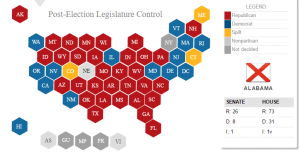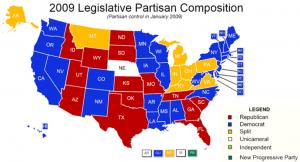Everyone is focusing on the outcome of the presidential election. They are not paying attention to Congress and still less to the states.
How could Hillary get a slight majority of the popular vote and the House is still solidly Republican?
Looking at the state legislature results helps to explain why. Compare 2016 with 2009.
Post-election 2016
2009
The Democrats have been almost completely focused on the office of the President. They want an emperor who will rule by decree, without the messy business of democratic consensus. But our federal system was set up to prevent an activist Federal government that responded to popular whims; only if the people really want something for a long time will they get it.
The Republicans have for years been doing the hard, unglamorous work of local politics: identifying and getting people elected to county councils, and then to state legislatures Two-thirds of state legislators are Republican. This is a pool of candidates for the House of Representatives. But this work does not get you on TV, does not get you invited to Hollywood dinners, does not get you the notice and the approbation of the New York Times.
The state legislatures influence, to some extent, voting laws and redistricting. Here the Democrats shot themselves in the foot by passing the Voting Rights Act that requires that minority voting power not be diluted. Minority, i.e. Democratic, voters vote at a lower rate than white voters, and so they have to be taken out of other districts and concentrated in one district which will reliably elect a minority, i.e. Democratic, representative. The Democrats failed to think through the consequences of this policy, no doubt because they regard logic as a tool of dead white male
oppression. If the minority – Democratic voters are put into one district, that means they are taken out of other districts, which therefore become less Democratic and more reliably Republican. And that is indeed what has happened. Minority districts elect minority Democratic representatives. The surrounding districts are far more likely to elect Republicans.
in 2013 Steven Hill explained it in The Atlantic:
But just in time for the redistricting in 1990, some enterprising Republicans began noticing a rather curious fact: The drawing of majority-minority districts not only elected more minorities, it also had the effect of bleeding minority voters out of all the surrounding districts. Given that minority voters were the most reliably Democratic voters, that made all of the neighboring districts more Republican. The black, Latino, and Asian representatives mostly were replacing white Democrats, and the increase in minority representation was coming at the expense of electing fewer Democrats. The Democrats had been tripped up by a classic Catch-22, as had minority voters: Even as legislatures were becoming more diverse, they were ironically becoming less friendly to the agenda of racial minorities.
The Democrats also outlawed at-large races because they diluted minority voting strength.
In 1967 the Democrats controlling Congress passed a law that mandated the use of single-seat districts for federal House races, both to prevent some recalcitrant southern Democrats from going to statewide winner-take-all elections to dilute the black vote and also as a way to facilitate the gerrymandering of majority-minority districts. Ironically, now it’s that very same district-based system that is dragging the Democrats underwater.
The minority Representatives have safe seats and are not inclined to give up their districts to help white Democrats. The Republicans are happy with the outcome. So the House looks to be reliably Republican until the Republicans overreach themselves and bring down the wrath of the electorate upon their heads – which they will do someday.

